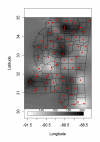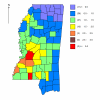Dry weather induces outbreaks of human West Nile virus infections
- PMID: 20181272
- PMCID: PMC2841181
- DOI: 10.1186/1471-2334-10-38
Dry weather induces outbreaks of human West Nile virus infections
Abstract
Background: Since its first occurrence in the New York City area during 1999, West Nile virus (WNV) has spread rapidly across North America and has become a major public health concern in North America. By 2002, WNV was reported in 40 states and the District of Columbia with 4,156 human and 14,539 equine cases of infection. Mississippi had the highest human incidence rate of WNV during the 2002 epidemic in the United States. Epidemics of WNV can impose enormous impacts on local economies. Therefore, it is advantageous to predict human WNV risks for cost-effective controls of the disease and optimal allocations of limited resources. Understanding relationships between precipitation and WNV transmission is crucial for predicting the risk of the human WNV disease outbreaks under predicted global climate change scenarios.
Methods: We analyzed data on the human WNV incidences in the 82 counties of Mississippi in 2002, using standard morbidity ratio (SMR) and Bayesian hierarchical models, to determine relationships between precipitation and human WNV risks. We also entertained spatial autocorrelations of human WNV risks with conditional autocorrelative (CAR) models, implemented in WinBUGS 1.4.3.
Results: We observed an inverse relationship between county-level human WNV incidence risk and total annual rainfall during the previous year. Parameters representing spatial heterogeneity in the risk of human exposure to WNV improved model fit. Annual precipitation of the previous year was a predictor of spatial variation of WNV risk.
Conclusions: Our results have broad implications for risk assessment of WNV and forecasting WNV outbreaks. Assessing risk of vector-born infectious diseases will require understanding of complex ecological relationships. Based on the climatologically characteristic drought occurrence in the past and on climate model predictions for climate change and potentially greater drought occurrence in the future, we suggest that the frequency and relative risk of WNV outbreaks could increase.
Figures


Similar articles
-
Effects of weather and landscape on the equine West Nile virus infection risk in Mississippi, USA.Geospat Health. 2015 Nov 4;10(2):357. doi: 10.4081/gh.2015.357. Geospat Health. 2015. PMID: 26618313
-
A continental risk assessment of West Nile virus under climate change.Glob Chang Biol. 2014 Aug;20(8):2417-25. doi: 10.1111/gcb.12534. Epub 2014 Feb 27. Glob Chang Biol. 2014. PMID: 24574161
-
West Nile virus is predicted to be more geographically widespread in New York State and Connecticut under future climate change.Glob Chang Biol. 2021 Nov;27(21):5430-5445. doi: 10.1111/gcb.15842. Epub 2021 Aug 29. Glob Chang Biol. 2021. PMID: 34392584
-
West Nile Virus in the New World: trends in the spread and proliferation of West Nile Virus in the Western Hemisphere.Zoonoses Public Health. 2009 Aug;56(6-7):357-69. doi: 10.1111/j.1863-2378.2008.01207.x. Zoonoses Public Health. 2009. PMID: 19486320 Review.
-
West Nile virus: epidemiology and clinical features of an emerging epidemic in the United States.Annu Rev Med. 2006;57:181-94. doi: 10.1146/annurev.med.57.121304.131418. Annu Rev Med. 2006. PMID: 16409144 Review.
Cited by
-
Laplace approximation for conditional autoregressive models for spatial data of diseases.MethodsX. 2022 Oct 1;9:101872. doi: 10.1016/j.mex.2022.101872. eCollection 2022. MethodsX. 2022. PMID: 36262319 Free PMC article.
-
Identification of Climatic Factors Affecting the Epidemiology of Human West Nile Virus Infections in Northern Greece.PLoS One. 2016 Sep 15;11(9):e0161510. doi: 10.1371/journal.pone.0161510. eCollection 2016. PLoS One. 2016. PMID: 27631082 Free PMC article.
-
Spatial connectivity in mosquito-borne disease models: a systematic review of methods and assumptions.J R Soc Interface. 2021 May;18(178):20210096. doi: 10.1098/rsif.2021.0096. Epub 2021 May 26. J R Soc Interface. 2021. PMID: 34034534 Free PMC article.
-
Could drought conditions trigger Schmallenberg virus and other arboviruses circulation?Int J Health Geogr. 2013 Feb 14;12:7. doi: 10.1186/1476-072X-12-7. Int J Health Geogr. 2013. PMID: 23409725 Free PMC article.
-
A comparison study of Zika virus outbreaks in French Polynesia, Colombia and the State of Bahia in Brazil.Sci Rep. 2017 Mar 21;7(1):273. doi: 10.1038/s41598-017-00253-1. Sci Rep. 2017. PMID: 28325935 Free PMC article.
References
-
- Nash D, Mostashari F, Fine A, Miller J, O'Leary D, Murray K, Huang A, Rosenberg A, Greenberg A, Sherman M, Wong S, Layton M, Campbell GL, Roehrig JT, Gubler DJ, Shieh WJ, Zaki S, Smith P. The outbreak of West Nile virus infection in the New York City area in 1999. New England Journal of Medicine. 2001;344(24):1807–1814. doi: 10.1056/NEJM200106143442401. - DOI - PubMed
Publication types
MeSH terms
LinkOut - more resources
Full Text Sources
Other Literature Sources
Medical
Miscellaneous

